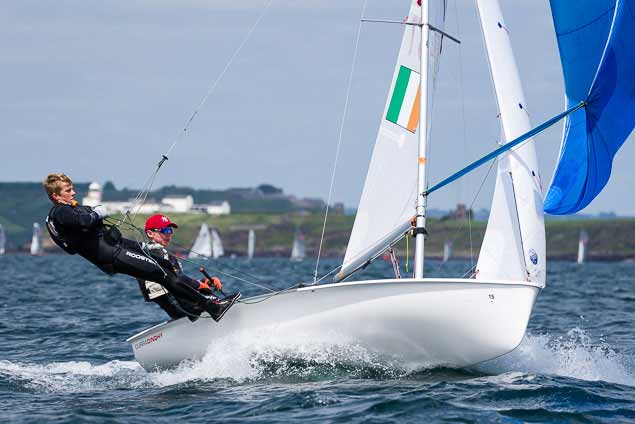Displaying items by tag: tr36
Kinsale Yacht Club Crew are Junior All Ireland Sailing Champions
Kinsale Yacht Club youth sailors Michael O'Suilleabhain and Michael Carroll were the winners of this afternoon's All Ireland Junior Sailing Championships sailed at the Fastnet Outdoor Marine Education Centre in TR 3.6 double handed dinghies.
Saturday's light and shifty conditions gave way to soid breeze for today's single medal race final.
 Tight competition in the junior all Ireland sailing finals in Schull. Scroll down for video below. Photo: Robin Bateman
Tight competition in the junior all Ireland sailing finals in Schull. Scroll down for video below. Photo: Robin Bateman
The West Cork pairing beat two National Yacht Club crews from Dun Laoghaire who were challenging for the overall title. Rian Geraghty-McDonnell and Harry Durcan and Loghlen Rickard and Nathan Van Steenberge finished second and third respectively.
Overall results:
| Michael O'Suilleabhain | Michael Carroll | Kinsale YC | (13) | 1 | 1 | 1 | 5 | 9 | 6 | 36 | 23 | ||||
| Rian Geraghty-McDonnell | Harry Durcan | National YC | (6) | 2 | 5 | 5 | 3 | 3 | 10 | 24 | 28 | ||||
| Loghlen Rickard | Nathan Van Steenberge | National YC | 2 | 6 | (9) | 3 | 6 | 2 | 14 | 42 | 33 | ||||
| Ronan Walsh | Tom Higgins | Royal CorkYC | 4 | 5 | 2 | 4 | 2 | (6) | 16 | 39 | 33 | ||||
| Johnny Durcan | Emily Cullen | Royal Cork YC | 1 | 3 | 3 | 2 | (7) | 5 | 20 | 41 | 34 | ||||
| Chris Bateman | Daniel Hegarty | Royal Cork YC | (7) (+5 SP) | 4 | 4 | 7 | 10 | 8 | 2 | 47 | 35 | ||||
| Jack Fahy | Noah McCarthy-Fisher | Lough Derg YC Royal Cork YC / Royal StGeorge YC | (19) (+5 SP) | 13 | 8 | 9 | 9 | 1 | 4 | 68 | 44 | ||||
| Luke McGrath | Kate Darcy | Royal Cork YC | (16) | 10 | 7 | 6 | 12 | 4 | 8 | 63 | 47 | ||||
| Caolan Croasdell | Alexander Farrell | Lough Ree YC | 10 | 9 | 6 | 11 | 4 | (15) | 12 | 67 | 52 | ||||
| Joseph Karauzum | TC Mulvenna | Ballyholme YC / County Antrim YC | 11 | 7 | 11 | 12 | 1 | (13) | 18 | 73 | 60 |
 Winning duo – The Kinsale Yacht Club youth sailors Michael O'Suilleabhain and Michael Carroll are a 420 dinghy partnership seen here at Dinghy Fest 2017 at Royal Cork Yacht Club. Photo: Bob Bateman
Winning duo – The Kinsale Yacht Club youth sailors Michael O'Suilleabhain and Michael Carroll are a 420 dinghy partnership seen here at Dinghy Fest 2017 at Royal Cork Yacht Club. Photo: Bob Bateman





























































